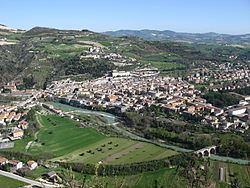Province / Metropolitan city Pesaro e Urbino (PU) Local time Wednesday 11:00 AM | Elevation 118 m (387 ft) | |
 | ||
Frazioni Calmazzo, Ghilardino, Isola di Fano, Mont'Alto, San Lazzaro, Torricella, Bellaguardia, San Gervasio, San Martino dei muri, San Piero in Tambis, Santa Maria della valle Demonym(s) Fossombronesi or Forsempronesi Weather 13°C, Wind SW at 8 km/h, 46% Humidity Points of interest Metauro, Pro Loco Forum Sempronii, Casa Museo ‑ Quadreri, Pinacoteca civica "AVernarecci" | ||
Fossombrone is a town and comune in the province of Pesaro e Urbino, Marche, central Italy.
Contents
- Map of 61034 Fossombrone Province of Pesaro and Urbino Italy
- History
- Main sights
- Religious buildings
- Secular buildings
- Sports
- Twin towns
- References
Map of 61034 Fossombrone, Province of Pesaro and Urbino, Italy
History
The ancient Roman colony of Forum Sempronii took its name from Gaius Sempronius Gracchus.
Near the Furlo Pass, during the Gothic War, was fought in 552 the Battle of Taginae, in which Totila was overcome by the Byzantine general, Narses.
Fossombrone was included in the Donation of Pepin, but remained subject to the Duchy of Spoleto until 1198, when it passed under Papal rule. The Malatesta sold it to the famous Federico III da Montefeltro, under whom the city flourished. Also positive for the city was the reign of the della Rovere dukes, who enlarged it (in particular, Francesco Maria II expanded the settlement in the lower area up to the Metauro river). In 1631 it returned to the Papal States, and was annexed to Italy in 1860.
Main sights
The city and its environs abound in antiquities, especially inscriptions. Noteworthy remains are the statue of the god Vertumnus; the Furlo Pass, constructed by the Emperor Vespasian to shorten the passage of that mountain; the bridge of Trajan (115) near Calmazzo, and the bridge now called Ponte della Concordia, originally built in 292 by Diocletian, both over the Metaurus.
